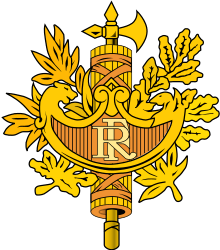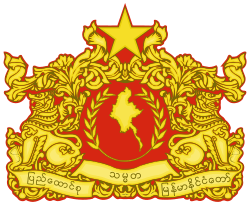France–Myanmar relations
France-Myanmar relations refers to interstate relations of Myanmar and France. Relations began in the early 18th century, as the French East India Company was attempting to extend its influence into Southeast Asia. France became involved upon the building of a shipyard in 1729 in the city of Syriam. The 1740 revolt of the Mon against Burmese rule however forced the French to depart in 1742. They were able to return to Siam in 1751 when the Mon requested French assistance against the Burmese. A French envoy, Sieur de Bruno was sent to evaluate the situation and help in the defense against the Burmese. French warships were sent to support the Mon rebellion, but in vain. In 1756, the Burmese under Alaungpaya vanquished the Mon. Many French were captured and incorporated into the Burmese Army as an elite gunner corps, under Chevalier Milard. In 1769, official contacts resume when a trade treaty was signed between king Hsinbyushin and the French East India Company.
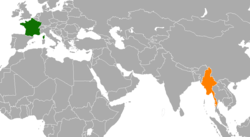 | |
France |
Myanmar |
|---|---|
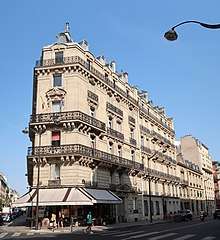
Soon however, France became embroiled in the French revolution and Napoleonic wars, giving way to overwhelming British influence in Burma. French contacts with Burma, effectively a British colony, would become almost non-existent, while from the second half of the 19th century France would concentrate in the establishment of French Indochina and the conflicts with China leading to the Sino-French war.
French shipyard in Syriam (1729–1742)
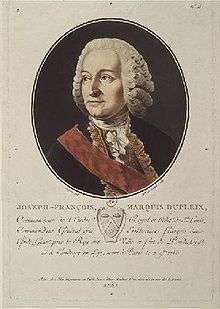
The Governor-General of French India Joseph François Dupleix had started to show interest in Burma since 1727, on account of the country's abundance in teak and crude oil. As a result, a French shipyard was established in the city of Syriam in 1729, building ships for Pondicherry.[1] The shipyard was abandoned in 1742 due to the revolt of the Mon.[1]
Intervention in Burma (1751)
A few years later, a Mon envoy visited Dupleix requesting French help in the fight against the Burmese.[2] Dupleix promised men and munitions and dispatched Sieur de Bruno with the objective of developing French influence in the country.[3] He arrived at Bago, Burma in July 1751.[4] Sieur de Bruno reported back that a few hundred French troops would be able to take control of the Irrawaddy Delta, triggering an official request by Dupleix to the French court to obtain the necessary military support.[5][6] Sieur de Bruno obtained a treaty[7] and formed an alliance between France and the Mons.[8]
Governor Thomas Saunders of Madras attempted to counter the French moves in the region by sending a military force to survey the island of Negrais under Captain Thomas Taylor. He also tried to negotiate the cession of Syriam to the British.[5] The Mons firmly opposed these attempts at British encroachment under the counsel of Sieur de Bruno, who had considerable influence at the Mon court and was especially on excellent terms with the Heir Apparent.[5] Saunders finally decided to occupy Negrais forcibly, occupying the island on 26 April 1753.[5]
However, Dupleix's proposals to take control of the Irrawaddy delta were rejected by the French government, strongly limiting his capacity to intervene there.[9]
Participation in the Burman-Mon conflict (1751–1756)
Following their 1740 revolt against Burmese rule, the Mon sacked Ava in 1752, and overran most of Burma, putting an end to the Toungoo dynasty.[10][11] Soon however, the Burmese were able to repeal the Mons under the leadership of Alaungpaya.[12] The Mons had to retreat, as Alaunpaya first recovered northern Burma, capturing the city of Ava on 14 January 1754.[13] By February 1755, Central Burma was secured.[1] The Burmese soon threatened the capital of Pegu, as well as the city of Syriam.
In Syriam, Sieur de Bruno was helping the Mons in organizing their defense.[14][15] Sieur de Bruno was insistently requesting more help from Pondicherry.[16] He acted as a military advisor to the Mons, and French warships participated in fighting against the Burmese in Syriam and Dagon (ancient Rangoon).[17]
Alaungpaya on the other hand was asking the British for guns and ammunitions.[16] Alaungpaya managed to capture Syriam in July 1756.[18] Sieur de Bruno and the other French with him were captured and tortured. Two French ships arriving two days after the capture of Syriam, Fleury and Galathée,[19] with reinforcements and supplies were also captured by Alaungpaya, when Alaungpaya forced Bruno to write a letter to trick them. The French captains were killed and the 200 sailors forced to join the Burmese army[18][19] Sieur de Bruno was roasted to death.[18] From the two ships, Alaugpaya managed to put his hands on 35 ships guns (24 pounders), five field guns, 1300 muskets, and a large quantity of ammunitions.[19] France was precluded from further intervention in Burma, with the advent of the Seven Years' War in Europe (1756–1763).
French elite corps
The French troops with their guns and muskets were incorporated in the Burmese army as gunners, and played a key role in the later battles between the Burmese and the Mons. They were treated well and received Burmese wives.[19] They became an elite corps, which was to play an important role in the Burmese battles against the Siamese and the Manchus.[17] One of them, the Chevalier Milard, was ultimately nominated Captain of the Guard and Master of the Ordnance for the Konbaung dynasty.[17]
When they reached old age, the French soldiers were able to retire Shwebo villages, with the spiritual support of a priest.[19] To this day, some Catholic villages are still extant in the area where an awareness of some European ancestry remains.[20]
Resumption of official contacts (1769)
In 1769, a French embassy led by M. Feraud was sent to resume official French East India Company contacts with Burma. He obtained a trade treaty, and the establishment of a French factory in the city of Rangoon.
The arrival of the embassy was facilitated by Chevalier Milard. The king of Burma Hsinbyushin welcomed Feraud's embassy,[21] and accepted Ferraud's offer for trade, in exchange for the supply of guns and ammunitions.[22] The king remitted a letter of agreement, which Feraud brought back to Pondicherry.
Given the previous involvement of the French with the dissident Mon under Sieur de Bruno, the king of Burma clearly specified that French arm trade should involved him only.[23] As a result of the embassy, the French obtained a large ground in Rangoon where they were able to establish warehouses.[23][24]
Franco-British rivalry (19th century)
With the advent of the French revolution in 1789 and the rise of Napoleon, France became less capable of involvement in faraway theaters such as Burma. Great Britain on the contrary was able to increase its influence, leading to the First Anglo–Burmese War (1823–1826) and the gradual extinction of Burmese sovereignty and independence. After the Second Anglo-Burmese War (1852), the British Empire annexed Lower Burma.
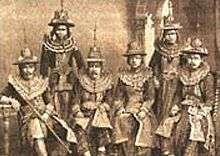
In 1872, king Mindon sent an embassy to Europe, led by his confidant, the Kinwun Mingyi,[25] leading to the signature of a commercial treaty with France on 24 January 1873.[26][27] Further, in 1883, king Thibaw Min attempted to break the stalemate with Great Britain by trying to establish an alliance with France to obtain recognition and aid. This led to strong tensions between France and Great Britain.[26] In the end, in spite of the dispatch of a Burmese mission to Paris, France refused in 1884 to sign a treaty promising that France would come to the support of Burma in case a third power would attack it, only suggesting the possibility of arm shipments from Tonkin.[26] In 1885, the French consul M. Hass moved to Mandalay and negotiated the establishment of a French Bank in Burma, a concession for a railway from Mandalay to the northern border of British Burma and a French role in running monopolies controlled by the Burmese government. A secret treaty signed between Hass and king Thibaw was disclosed.[28] The British reacted with diplomatic force. Charles Bernard, the Chief Commissioner of Lower Burma, warned that "if Ava refuses to stop the treaty, annexation will be inevitable".[29]
The French government recalled Haas, who was removed allegedly "for reasons of health". While the French had backed down in Burma, the French actions as well as many other events nevertheless convinced the British to take action against Burma.[30] Finally, the Third Anglo-Burmese War (1885), staged while France was occupied with the Sino-French war (1884–1885), resulted in the total annexation of Burma by Great Britain.
With the completion of British rule in Burma, French contacts with Burma would become almost non-existent, while France would concentrate in the establishment of French Indochina from the second half of the 19th century.
20th century
Following the end of World War II, ambassador-level diplomatic relationships between France and Burma were established in 1948, soon after the Burmese nation became an independent republic on 4 January 1948, as Union of Burma, with Sao Shwe Thaik as its first President and U Nu as its first Prime Minister.
See also
- France-Thailand relations
- France-Vietnam relations
Notes
- Hall, Burma, p. 78.
- Harrison, p. 148.
- Hall, Europe and Burma, p. 62. ("Dupleix promised them men and munitions, but before deciding how far to commit himself he sent over his agent, the Sieur de Bruno, to Pegu.")
- Hall, Burma, p. 78–79.
- Hall, Burma, p. 79.
- Harrison, p. 148. ("Soon after his arrival in 1751 the agent, Sieur de Bruno, reported back to Pondicherry that the Irrawaddy delta could easily be conquered by a small force.")
- Liang, p. 14. ("In July 1751, Dupleix sent Sieur de Bruno to Burma and negotiated a treaty by which, in return for commercial concessions, the Mons were to receive substantial French aid.")
- Lamb, p. 64. ("In 1751 Dupleix sent the Sieur de Bruno to Pegu to initiate an alliance between the French and the Mon Government at Pegu against the Burmans.")
- Hall, Burma, p. 80
- The New Encyclopædia Britannica, page 752, Robert McHenry, 1993: "Assailed from all sides, Ava fell to the Mons in 1752; and the whole of Myanmar passed under Mon rule".
- Encyclopædia Britannica 1970 Page 441 "In 1752 they captured Ava and the Toungoo dynasty finally collapsed"
- Lang, p. 28.
- Hall, Burma, p. 77
- Hall, Burma, p. 78, 81.
- Hall, A History of South-east Asia, p. 382. ("Moreover, the Mons were aided by a brilliant Frenchman, the Sieur de Bruno, whom Dupleix had sent some years earlier to Pegu as his agent.")
- Hall, Burma, p. 81
- Findlay, p. 277
- Hall, Burma, p. 82.
- Harvey, p. 231.
- Myint-U, p. 27
- Burma: A Historical and Political Analysis, page 17 by Frank N. Trager, 1966: "he acknowledged the presents of their ambassador, Feraud..."
- James, Helen. "Hsinbyushin". In Ooi, p. 611.
- Koenig
- SOAS, p. 194
- The United States and Burma, page 79 by John F. Cady, 1976: "In 1872, Mindon had dispatched a high-level diplomatic mission to Europe, headed by his confidant, the Kinwun Mingyi"
- Chandler & Steinberg, p. 181.
- Burma Under British Rule—and Before, page 56 by John Nisbet, 1901
- Morrison, p. 29
- Myint-U, p. 188
- Rapson et al., p. 437. ("What forced the English to act was that France, having won an empire in Indo-China, now tried to dominate Upper Burma by peaceful penetration.")
References
- Hall, D.G.E. Burma (3rd edition). Hutchison (1960). OCLC 4379359.
- Hall, D.G.E. Europe and Burma: A Study of European Relations with Burma to the Annexation of Thibaw's Kingdom, 1886. Oxford University Press (1945). OCLC 1444846.
- Hall, D.G.E. A History of South-east Asia. Macmillan, St. Martin's Press (1964). OCLC 411176.
- Harrison, Brian. South-east Asia: A Short History (2nd edition). Macmillan (1963). OCLC 1239026.
- Findlay, Ronald and Kevin H. O'Rourke. Power and Plenty: Trade, War, and the World Economy in the Second Millennium. Princeton University Press (2007). ISBN 978-0-691-11854-3.
- Harvey, G.E. History of Burma: From the Earliest Times to 10 March 1824. Asian Educational Services (2000). ISBN 978-81-206-1365-2.
- Koenig, William J. The Burmese Polity, 1752–1819. Center for South and Southeast Asian Studies, University of Michigan (1990). ISBN 978-0-89148-056-3.
- Lamb, Alastair. The Mandarin Road to Old Hué: Narratives of Anglo-Vietnamese Diplomacy. Chatto & Windus (1970). OCLC 107258.
- Liang, Chi Shad. Burma's Foreign Relations: Neutralism in Theory and Practise. Praeger (1990). ISBN 978-0-275-93455-2.
- Myint-U, Thant. The Making of Modern Burma. Cambridge University Press (2001). ISBN 978-0-521-79914-0.
- Ooi, Keat Gin. Southeast Asia: A Historical Encyclopedia, from Angkor Wat to East Timor. ABC-CLIO (2004) ISBN 978-1-57607-770-2.
- Rapson, Edward James et al. The Cambridge History of India. Cambridge University Press (1932). OCLC 875984.
- SOAS Bulletin of Burma Research, Vol. 2, No. 2, Autumn 2004, ISSN 1479-8484 ("A voyage to Pegu", translation of A Voyage to the East-Indies and China; Performed by Order of Lewis XV. Between the Years 1774 and 1781. Containing A Description of the Manners, Religion, Arts, and Scieneces, of the Indians, Chinese, Pegouins, and of the Islanders of Madagascar; Also Observations on the Cape of Good Hope, the Isles of Ceylon, Malacca, the Philippines, and Moluccas. by Pierre Sonnerat, Commissary of the Marine, (Vol. III, book 4, chapter 2).
